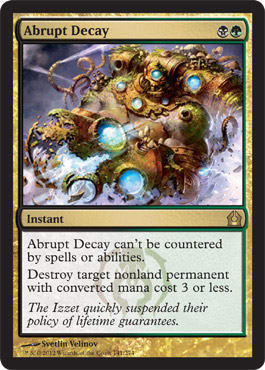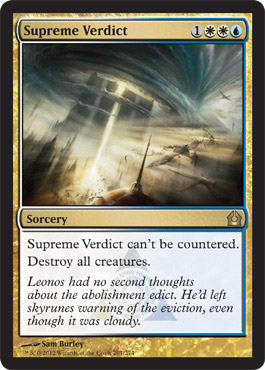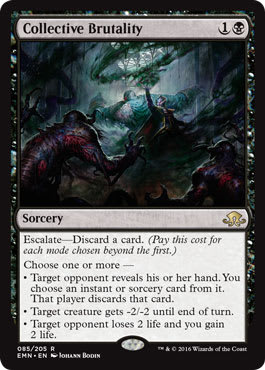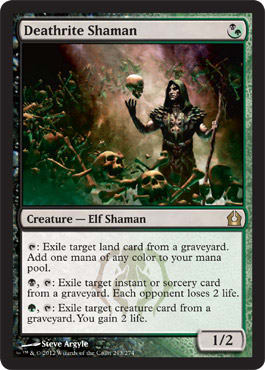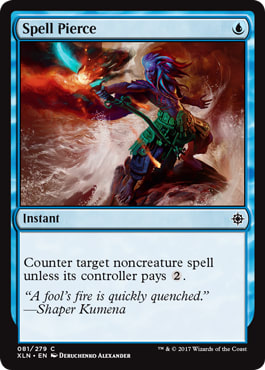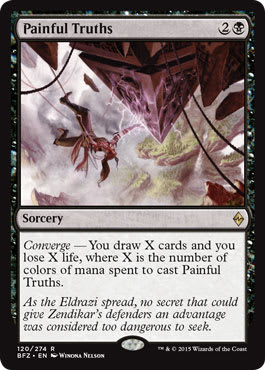Okay, so I punted on-camera against Jody Keith in the final game of my final match of the SCG Open in Louisville this past weekend. I can get past that, as momentary lapses in focus can (and should!) result in major negative consequences for your tournament. It was disappointing to lose to a theoretically good matchup, which then led our team to miss out on Top 8, but I only know of one way to get over a tough loss, and that is to go over some super sweet Legacy decks that are finally playable in the wake of Miracles’ departure from the format. It’s a brewer’s paradise out here, and now that we don’t have to play Abrupt Decay, a few new Blue midrange decks are creeping back into the limelight. Let’s talk about the two decks I tested in the days leading up to the Team Constructed Open, Esper Stoneblade and Dimir Garbage.
Now, I have a patented formula for building Esper Stoneblade, honed over years of playing variants on the deck from 2011 through 2015. More so than almost any other fair midrange deck, it revolves around having a complete, 75-card deck where you make sure that your deck is like a Venn Diagram, with a perfect 60-card sub-deck for each and every matchup you might face. Esper Stoneblade is the deck that leans most heavily on its sideboard to improve bad matchups, where you’ll want to be flush with Force of Wills and Thoughtseizes in one spot and Swords to Plowshares and Supreme Verdicts in another. Fortunately, you can usually stitch it all together, given the power of cards like Brainstorm and Ponder, to give yourself the coveted “55% against everything” gold standard of a fair midrange deck. I played Stoneblade in a few leagues on MTGO, going 9-1 (while getting very lucky, mind you!) and I’m excited to jam more games with it before GP Las Vegas this summer. Though I didn’t end up playing Stoneblade at the Open (for a couple reasons, which I’ll get to), this is where my testing and theorizing led:
Esper Stoneblade ? Legacy | Ben Friedman
- Creatures (10)
- 2 True-Name Nemesis
- 4 Snapcaster Mage
- 4 Stoneforge Mystic
- Planeswalkers (2)
- 2 Jace, the Mind Sculptor
- Instants (14)
- 2 Spell Pierce
- 4 Brainstorm
- 4 Force of Will
- 4 Swords to Plowshares
- Sorceries (10)
- 2 Supreme Verdict
- 2 Thoughtseize
- 3 Collective Brutality
- 3 Ponder
- Artifacts (3)
- 1 Batterskull
- 1 Engineered Explosives
- 1 Umezawa's Jitte
- Lands (21)
- 1 Plains
- 1 Swamp
- 2 Island
- 1 Marsh Flats
- 1 Scrubland
- 2 Underground Sea
- 2 Wasteland
- 3 Tundra
- 4 Flooded Strand
- 4 Polluted Delta
- Sideboard (15)
- 2 Engineered Explosives
- 1 Supreme Verdict
- 3 Meddling Mage
- 2 Thoughtseize
- 3 Surgical Extraction
- 1 Collective Brutality
- 1 Spell Pierce
- 2 Fatal Push
Now, this is a bit different than many people’s Stoneblade decks. The first thing to note is that there is no Karakas in the mana base, because it’s a nonbasic Plains most of the time, and the minor percentage added in the Sneak and Show matchup is not worth having a nonbasic Plains. Better than a Karakas would be a third Wasteland for general purpose use, as that card allows you to close the window on a game in which you are already ahead.
The second eye-catcher is the three total Supreme Verdicts in the 75. Verdict is a card that lay in Terminus’ shadow for ages, but with the one-mana sweeper gone, the uncounterable four-mana sweeper has an opportunity to shine. This is a prime example of a card that most opponents won’t be ready to play around, and it will lead to its fair share of massive blowouts as folks learn to respect a sweeper from the Blue deck on turn four. With everyone leaning hard on Gurmag Angler, True-Name Nemesis, and other creatures that shrug off most targeted removal in the format, and with Toxic Deluge (paying five life, of course, to try to kill a Gurmag Angler) so vulnerable to a Force of Will, it’s time for the real Wrath of God to show up and break a few hearts.
The third, and most important, major innovation here is the heavy use of Collective Brutality as the supplemental removal spell to Swords to Plowshares. Most folks don’t understand Brutality, but it is quietly becoming one of the best spells in both Legacy and Modern. We’ll save the Modern Dredge discussion for later, but Brutality is a split card between a bad Duress and a bad Disfigure, and that is exactly what the doctor ordered for a fair deck caught between the Storm and Delver decks in this metagame. No, you do not escalate the card all that much. No, you do not need Lingering Souls for the cute synergy between Souls and Brutality. But it sure does feel great to have a deck with eight Duress effects post-sideboard against Storm and Sneak and Show while having ten cheap removal spells post-sideboard against Delver, Elves, Death and Taxes, Burn, and the like.
A few additional notes on Brutality: There is rationale to playing Lingering Souls on its own merits, but the inclusion of Collective Brutality does little to change the calculus on which 3-drop sorcery speed “doesn’t interact with combo decks” creature you’d like to play. True-Name Nemesis is the higher-power-level card, it pitches to Force of Will, and it stands tall against opposing Gurmag Anglers.
As for when to escalate, there are a select few scenarios where it makes sense to pitch the extra card. The first is when playing against a Delver deck, with an extra mana up to play around Daze, and I have an excess of lands or a single Force of Will and no Blue card to pitch or an excess of expensive spells with only three lands (think two Jaces, two Snapcaster Mages, and a Batterskull in hand). Usually the opponent will be tapped out with two or three cards in their hand, and you can kill a Delver while sniping a key Brainstorm or Ponder to really run the opponent out of gas. If they have four or five cards in hand, you’re way more likely to run into Force of Will, which trades for card parity but leaves the pressure of the creature on the table. Obviously each scenario is different, but there are times it’s correct to escalate and times it isn’t. When in doubt, don’t escalate, and almost never escalate your Brutality if you don’t have an extra land up to play around Daze.
The second time you can escalate your Collective Brutality is against midrange Deathrite Shaman or Stoneforge Mystic decks. It’s typically much better to escalate in the post-board games, as your opponents will board out or shave down on Force of Wills. Often you can lead Thoughtseize into an escalated Brutality on the opponent’s Deathrite Shaman or Stoneforge Mystic, taking a Brainstorm or Ponder and leaving them with rags to work with. If you can strand a Batterskull in the opponent’s hand with no Brainstorm effect to shuffle it away, that’s even better.
The third time to escalate Collective Brutality (and one of my personal favorites) is against Storm, when they board in Xantid Swarm expecting you to have cut all of your removal. This slam-dunk play often ends the game on the spot, and almost singlehandedly justifies Brutality in the deck.
The fourth time to escalate Collective Brutality is against Elves, depending on your hand and how ready they are to go for a big Natural Order or Glimpse of Nature turn. Simply eating a Wirewood Symbiote and a Green Sun's Zenith can go a long way toward shutting down their game plan as well, but it’s particularly sweet to kill a combo elf piece and take their Glimpse of Nature along with it, buying you many turns to establish a Jitte lock.
The fifth time to escalate Brutality is against Burn. This one should be self-explanatory.
For a brief sideboard guide, typically against Delver some number of Force of Wills, Thoughtseizes, Jaces, and Spell Pierces leave for the extra Brutality, Supreme Verdict, Fatal Pushes, and Engineered Explosives. Jace can go if you expect Pyroblast and Lightning Bolt, and on the draw Jace is particularly underwhelming. Force of Will is abysmal on the play, but playable on the draw, and often you see a straight swap of Jaces for Force of Wills or vice versa for Game 3.
Against combo decks like Storm and Sneak and Show, you’ll cut the Swords to Plowshares, Supreme Verdicts, and the complete Stoneforge package for Surgical Extractions, Thoughtseizes, the extra Pierce and Brutality, Engineered Explosives, and Meddling Mages. (Obviously Explosives is horrible against Sneak and Show, but playable against Storm as an answer to Empty the Warrens, Carpet of Flowers, and Xantid Swarm, and Supreme Verdict is playable against Sneak and Show as an answer to Show and Tell + Emrakul, the Aeons Torn.) True-Name Nemesis is pretty bad here as well, but as a Blue card to pitch to Force of Will, it’s slightly better than keeping in some number of Stoneforge Mystic.
Now, one possibility to explore is in playing a single Sword of Feast and Famine or Sword of Fire and Ice in the sideboard over the one Spell Pierce to justify keeping in the Stoneforge Mystics, which would then mean that a sideboard plan against the combo decks would involve cutting the Swords to Plowshares, the True-Name Nemeses, the Supreme Verdicts, the Jitte, and the Engineered Explosives for Surgicals, Thoughtseizes, the extra Brutality, the Meddling Mages, and the Sword of your choice. Typically the “sideboard an equipment so your Stoneforge Mystics are less embarrassing against combo decks” plan is fairly suspect, but in this case it might be worth it for the additional value the Stoneforges gain against fair midrange Blue decks.
Of course, for a certain type of Legacy aficionado, Stoneblade is the pinnacle of cool interactions, but it is not the deck I ended up playing in the Open. Stoneforge Mystic herself was fairly underwhelming, and at one point, I asked myself why I was playing Mystic (and by an extension, White cards) at all. Deathrite Shaman is a super-powerful card, and Gurmag Angler is the last, best way to abuse Delve in Legacy, so it made sense to explore the old Sultai Garbage shell, this time putting the Green cards on hold. The end result was a beautiful “sculpture of garbage”, to paraphrase some recent commentary from my last feature match, and after fifteen rounds of Legacy, the updated list is right here:
Dimir Garbage ? Legacy | Ben Friedman
- Creatures (13)
- 2 True-name Nemesis
- 3 Gurmag Angler
- 4 Deathrite Shaman
- 4 Snapcaster Mage
- Planeswalkers (2)
- 2 Jace, the Mind Sculptor
- Instants (17)
- 1 Diabolic Edict
- 2 Spell Pierce
- 2 Thought Scour
- 4 Brainstorm
- 4 Fatal Push
- 4 Force of Will
- Sorceries (6)
- 3 Collective Brutality
- 3 Ponder
- Artifacts (1)
- 1 Engineered Explosives
- Lands (21)
- 2 Island
- 2 Swamp
- 1 Bayou
- 1 Tropical Island
- 2 Misty Rainforest
- 3 Underground Sea
- 3 Verdant Catacombs
- 3 Wasteland
- 4 Polluted Delta
- Sideboard (15)
- 4 Thoughtseize
- 2 Marsh Casualties
- 2 Diabolic Edict
- 3 Surgical Extraction
- 2 Engineered Explosives
- 1 Painful Truths
- 1 Collective Brutality
Both Liliana, the Last Hope and Liliana of the Veil failed to impress, so Diabolic Edict and Painful Truths replace them in this updated list. Counterspell and Spell Snare are solid cards, but Spell Pierce does most of what I’d like those cards to do while being rather flexible. It’s possible that Flusterstorm is better than Spell Pierce right now, but there is value in countering a Sneak Attack, Jace, Aluren, Blood Moon, or other random large permanent, more so than the extra percentage against Storm Combo.
Again, this is a list that maximizes the flexibility of Collective Brutality and Snapcaster Mage with the power of Deathrite Shaman and Gurmag Angler. Even though it’s shed two of the original four colors, this list is the true scion of the Four-Color Delver decks of recent Legacy formats. Without Miracles in the format, there’s little need for Abrupt Decay, and with the advent of Fatal Push, there’s less incentive to play Red for Lightning Bolt. Delver and Lighting Bolt go together like peas and carrots, so the circumstances were perfect for cutting both splash colors altogether and running with a lean, basic-heavy midrange deck, one that morphs into every deck’s worst nightmare post-sideboard. As for the losses of Leovold, Emissary of Trest and Abrupt Decay, the replacements of True-Name Nemesis and Collective Brutality are much, much better suited to today’s metagame, and allow the luxury of four basic lands in the deck. It’s ironic, how the loss of a deck that frequently played Blood Moon or From the Ashes itself (Miracles) paradoxically reduced the pressure on the Blue midrange decks to stretch for third and fourth colors of mana.
The quick and dirty sideboard guide is very similar to the one for Stoneblade. Against Storm, you’ll be sideboarding out your Fatal Pushes, your Diabolic Edict, a Gurmag Angler, both True-Name Nemeses, and a Swamp for Thoughtseizes, Brutality, two Surgicals, and an Engineered Explosives or Painful Truths. Against Sneak and Show, the plan is similar, but you’re cutting your Explosives and bringing in your Diabolic Edicts. Against Delver, you’re cutting some number of Force of Wills, Jaces, and Spell Pierces for Explosives, Edicts, Brutality, and possibly the Marsh Casualties (depending on how many True-Name Nemesis or Young Pyromancers you see.)
If you’ve been waiting to dip your toes into the Legacy waters, this is the perfect time to get involved. Storm and Delver are in some ways easier boogeymen to handle than Miracles, and everything from Five-Color Silvers to Zero-Color Eldrazi are viable archetypes. Put on your brewing gloves, because Legacy is particularly exploitable right now, and you owe it to yourself to give it a shot!
















